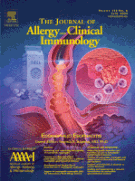CD163 expression defines specific, IRF8-dependent, immune-modulatory macrophages in the bone marrow - 04/11/20

Abstract |
Background |
Scavenger receptor CD163 is exclusively expressed on monocytes/macrophages and is widely used as a marker for alternatively activated macrophages. However, the role of CD163 is not yet clear.
Objectives |
We sought to examine the function of CD163 in steady-state as well as in sterile and infectious inflammation.
Methods |
Expression of CD163 was analyzed under normal and inflammatory conditions in mice. Functional relevance of CD163 was investigated in models of inflammation in wild-type and CD163−/− mice.
Results |
We describe a subpopulation of bone marrow–resident macrophages (BMRMs) characterized by a high expression of CD163 and functionally distinct from classical bone marrow–derived macrophages. Development of CD163+ BMRMs is strictly dependent on IFN regulatory factor-8. CD163+ BMRMs show a specific transcriptome and cytokine secretion pattern demonstrating a specific immunomodulatory profile of these cells. Accordingly, CD163−/− mice show a stronger inflammation in allergic contact dermatitis, indicating a regulatory role of CD163. However, CD163−/− mice are highly susceptible to S aureus infections, demonstrating the relevance of CD163 for antimicrobial defense as well.
Conclusions |
Our data indicate that anti-inflammatory and immunosuppressive mechanisms are not necessarily associated with a decreased antimicrobial activity. In contrast, our data define a novel macrophage population that controls overwhelming inflammation on one hand but is also necessary for an effective control of infections on the other hand.
Le texte complet de cet article est disponible en PDF.Graphical abstract |
Key words : Resident bone marrow macrophages, scavenger receptor CD163, IFN regulatory factor 8, sterile and systemic inflammation
Abbreviations used : ACD, BM, BMC, BMC w/o BMRM, BMDM, BMRM, CSF-1, DE, DEX, GO, GR, MACS, MAF, PE, ROS, WT
Plan
| This work was supported by grants of the Interdisciplinary Center of Clinical Research at the University of Muenster (grant no. Ro2/003/15 to J.R.) and the German Research Foundation (Deutsche Forschungsgmeinschaft; DFG) Collaborative Research Center (CRC) 1009 B1, B9, and Z2 to S.N. and J.R., CRC Transregio 34, C13(N), DFG CRU 342 P3, and Mye-EUNITER to K.B-K. and J.R., the Excellence Cluster ImmunoSensation to J.L.S., the Excellence Cluster “Cells in Motion” to J.R., and the CRC 914 (A10) as well as the Deutsches Zentrum für Herz-Kreislauf-Forschung (DZHK; German Centre for Cardiovascular Research, High Risk High Volume) and the BMBF (Bundesministerium für Bildung und Forschung; German Ministry of Education and Research) to C.Sch. C.Str. was supported by a Gerok position of the CRC 914. |
|
| Disclosure of potential conflict of interest: The authors declare that they have no relevant conflicts of interest. |
Vol 146 - N° 5
P. 1137-1151 - novembre 2020 Retour au numéroBienvenue sur EM-consulte, la référence des professionnels de santé.
L’accès au texte intégral de cet article nécessite un abonnement.
Déjà abonné à cette revue ?

